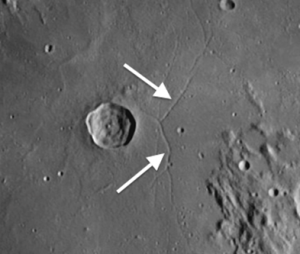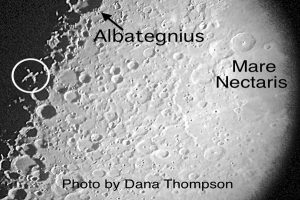The week of April 4-10 takes us from Day 4 to Day 9. This week we will highlight the Triesnecker rilles on the moon and an object informally known as the “Lunar X.”
 Triesnecker Rilles: [NE/J10] What a great place to poke around with your telescope! This is such a complex system of rilles that it looks like a railway switchyard! Which do you think came first, the crater or the rilles1?
Triesnecker Rilles: [NE/J10] What a great place to poke around with your telescope! This is such a complex system of rilles that it looks like a railway switchyard! Which do you think came first, the crater or the rilles1?
The width of the rilles measures between one-half mile and one mile. The largest rilles can be seen in a three-inch refractor, but the whole system requires larger apertures and good seeing. There are at least nine rilles crisscrossing each other. Make a sketch of how many you can see, then come back later and try to improve on it.
Scientists are not sure how the Triesnecker rilles developed. Their origin still remains a mystery, but the consensus is they are not grabens (as the above Ariadaeus rille is). Enjoy them as one of the Moon’s many enigmas.
OF ADDITIONAL INTEREST IN SPACE:
 Lunar X: [SE/M10; L=1°E] Around 6 days 22 hours (depending on libration–you have to get this pretty exact, it’s a narrow window) as the terminator crosses the crater Blanchinus, the Sun will light up the mountain peaks immediately to the west of the crater and you will see a brilliantly lit “X” at the intersection of the rims of Blanchinus, La Caille, and Purbach. Look for it when the terminator is around 1°-2° east. Once it has formed, the image will last only for about three hours. The formation is also known as the Purbach Cross and the Werner X. (Because it is not an officially recognized object, you will not find it listed on the Field Map.)
Lunar X: [SE/M10; L=1°E] Around 6 days 22 hours (depending on libration–you have to get this pretty exact, it’s a narrow window) as the terminator crosses the crater Blanchinus, the Sun will light up the mountain peaks immediately to the west of the crater and you will see a brilliantly lit “X” at the intersection of the rims of Blanchinus, La Caille, and Purbach. Look for it when the terminator is around 1°-2° east. Once it has formed, the image will last only for about three hours. The formation is also known as the Purbach Cross and the Werner X. (Because it is not an officially recognized object, you will not find it listed on the Field Map.)
1There is a rille approaching Triesnecker’s northeast rim that looks like it has been interrupted by the crater, suggesting that the rilles were there first.
======================
It is highly recommended that you get a copy of Sky and Telescope’s Field Map of the Moon, the very finest Moon map available for use at the telescope. It is available for $10.95 at www.skyandtelescope.com and on Amazon. All features mentioned in this blog will be keyed to the grid on the Field Map and will look like this: Plato: [NW/D9]
Credits:
Courtesy of Gray Photography of Corpus Christi, Texas
Lunar photos: NASA / USGS / BMDO / LROC / ASU / DLR / LOLA / Moon Globe. Used by permission
- Rupes Cauchy: A Best Known Fault on the Moon - July 22, 2024
- Moon Crater Schickard – Crater Floor has Stripes - July 15, 2024
- Moon Craters Langrenus and Vandelinus - July 8, 2024